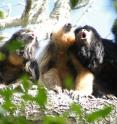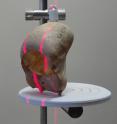For howler monkeys, deeper roars mean less sperm
Related images
(click to enlarge)
Howler monkeys are named for their impressive howling roars. Their vocal abilities are linked to long vocal folds and a hyoid bone uniquely adapted to resonate sound, making males seem bigger than they really are. Now, researchers reporting in the Cell Press journal Current Biology on October 22 show that howler monkeys with the most exceptional voices have paid for those abilities in sperm. Species with larger hyoid bones have smaller testes and vice versa. "We have strong evidence that howler monkey species that invest in larger vocal organs produce less sperm," says Jacob Dunn of the University of Cambridge. "This is the first evidence in any species for a trade-off between vocal investment and sperm production."
The new findings further an idea first espoused by Charles Darwin on the effects of sexual selection. Under the theory, species often face trade-offs in reproduction between characteristics that are useful in competing for mates and those that are useful in fertilizing eggs.
Males of many species are endowed with large bodies, bold colors, or "weapons"--think antlers and horns. In many cases, those sexually selected features come at a cost. In the new study, Dunn, senior author Leslie Knapp of the University of Utah, and colleagues wondered if the same could be said of howler monkeys' howls.
The researchers examined the vocal tract dimensions and the calls of male howler monkeys, gathering evidence to represent a total of nine different species. They found that species characterized by single-male groups have larger hyoids and smaller testes, suggesting high levels of vocal competition. Monkeys with larger hyoids produce sounds with lower frequencies, most likely to give the impression based on acoustics of larger body size. Across species, testes volume increased along with the number of males per group, indicating the importance of sperm competition. Those males more generously endowed with large testes also had smaller-than-average hyoids.
It's pretty simple really, Dunn says: "When it comes to reproduction, you can't have everything."
It's hard to say exactly how the trade-off works, however. "Investment in developing a large vocal organ and roaring may be so costly that there is simply not enough energy left to invest in testes," Dunn says. "Alternatively, using a large vocal organ for roaring may be so effective at deterring rival males that there is no need to invest in large testes."
Dunn says they are now carrying out more detailed analyses of howler monkeys' vocal anatomy to better understand how this determines the acoustics of their calls. They'll also be looking to see whether the trade-offs they've found between species also exist among individuals within a species.
Source: Cell Press
Articles on the same topic
- Deeper calls, smaller ballsThu, 22 Oct 2015, 17:35:17 UTC
- Calls vs. balls: Monkeys with more impressive roars produce less spermThu, 22 Oct 2015, 17:34:55 UTC
Other sources
- Seductive Bass Tones Enough to Seal the Deal in Some Monkey Speciesfrom NY Times ScienceThu, 22 Oct 2015, 23:20:05 UTC
- Study: The louder the howler monkey, the smaller his testiclesfrom UPIThu, 22 Oct 2015, 19:30:25 UTC
- (Balls) Size Matters For Howler Monkey Mating Calls | Videofrom Live ScienceThu, 22 Oct 2015, 19:00:29 UTC
- Deeper Calls, Smaller Ballsfrom Newswise - ScinewsThu, 22 Oct 2015, 17:40:04 UTC
- Calls vs. balls: Monkeys with more impressive roars produce less spermfrom Science DailyThu, 22 Oct 2015, 17:30:05 UTC
- Big testicles mean a softer voice, at least in howler monkeysfrom Science NOWThu, 22 Oct 2015, 16:40:05 UTC
- Howler Monkeys with Deeper Calls Have Smaller Ballsfrom Live ScienceThu, 22 Oct 2015, 16:31:05 UTC
- Calls vs. balls: Monkeys with more impressive roars produce less spermfrom PhysorgThu, 22 Oct 2015, 16:10:21 UTC


